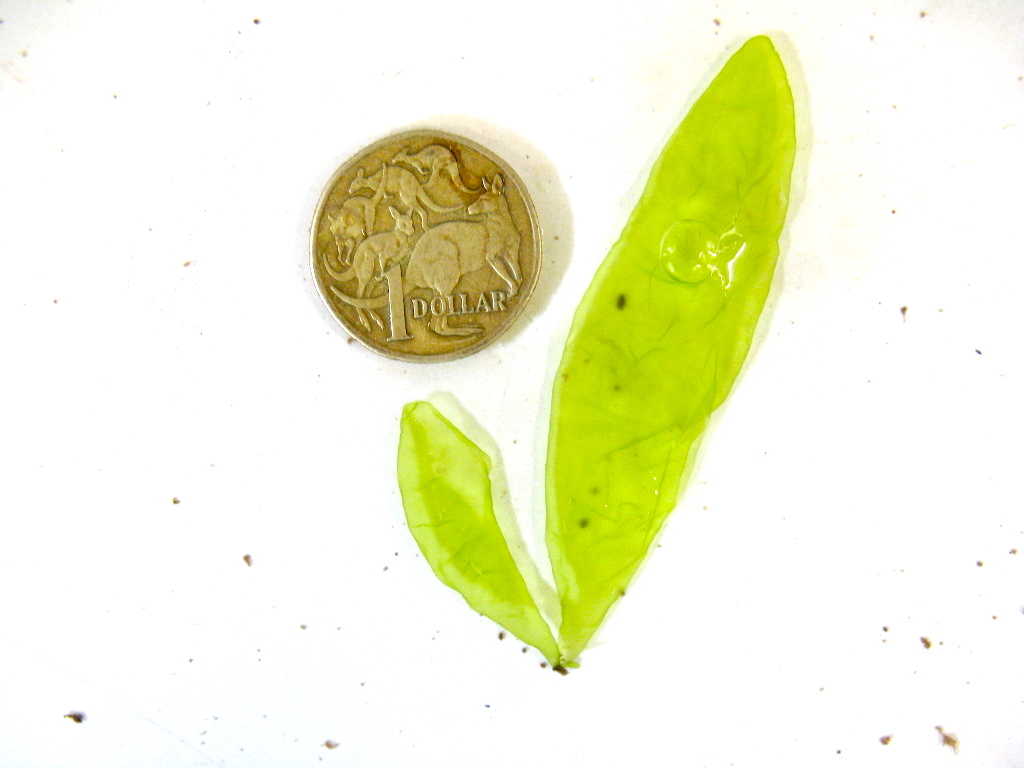This species forms greens sacs from a few to 30 cm tall that can be spherical (Image A) to elongate in outline (Image B). These sacs tear open to varying degrees depending on habitat to form open cups or vases (Image C) and eventually monostromatic blades with a residual cup adjacent to the holdfast (Image D). Rehydrated material reveals surface cells that are angular and cuboidal to irregular in outline, 5-22 µm in dimensions, and closely compacted together (Image E). In section the blades are clearly monostromatic, 20-30(40) µm wide, with the cells roughly cuboidal in outline (Image F). Fresh material reveals 1(2) pyrenoids per cell typically with 2(3) in cells closer to the base.
Based on moderate collections (n = 45) this is the most common genetic group in the NW Atlantic and extends into our Arctic flora (northern Labrador, n = 1). We have no verified records for BC, but the number of Monostroma spp. specimens studied from there is low (n = 4) and absence may reflect a sampling artifact (see Monostroma cf. arcticum Wittrock and Monostroma cf. fractum C.-C.Jao). This species extends from upper intertidal pools to subtidal (4 m), growing on rock, other hard substrata, as well as other algae. It can be difficult to distinguish from Monostroma cf. arcticum Wittrock with which it overlaps in range, but that species tends to have a slight propensity to rectangular cells which run parallel to the axis of the thallus, a more immediate transition to the blade morphology (only found as a sac in the smallest individuals) and is rare in the NW Atlantic flora with our few records being from ME and NB. All species of Monostroma can be confused with Gayralia oxysperma (Kützing) K.L.Vinogradova ex Scagel & al., but in surface view that species has its cells in groups of 2-4 with relatively larger gaps between these groups (i.e. they are not compact in surface view as is the case for Monostroma spp.; Image E).
The “cf.” used for all Monostroma spp. here is an indicator that taxonomy for the genus needs considerable work. There are unequivocally three genetic groups in our flora to which I tentatively apply three names (based on sequence data in BOLD a fourth genetic group collected in WA is distant to the three referred to here, and may represent another species of this genus). Accepting these preliminary name assignments for now, the Atlantic and Arctic Monostroma cf. grevillei (Thuret) Withering (matching sequence data from Germany, Central Norway and the UK; all relatively near the type locality in France) is a close sibling species to the Pacific Monostroma cf. fractum C.-C.Jao (for which we have only 1(2 in the works?) collection from Haida Gwaii. Based on the few collections in hand (no current matches in GenBank), Monostroma cf. arcticum Wittrock, with a type locality in the Arctic waters of Norway, is distributed in northern New England and the Maritime Provinces, Haida Gwaii, and Kamchatka, possibly consistent with a circumpolar distribution. Obviously we need considerably more hits on all three genetic groups to sort out the taxonomy and full distribution of the respective species.

Image A. Spherical sac from small ‘tidal rapids’ at Sam Orr’s Pond, NB (GWS037978).

Image B. Elongate sac from a high intertidal pool at our exposed Lepreau biodiversity station, NB (GWS036911).

Image C. Elongate sac from a high intertidal pool at our exposed Lepreau biodiversity station, NB, which is transitioning from a sac to a blade, but retains a sac-like habit over much of the thallus (GWS036918).

Image D. Essentially a monostromatic blade with the remnant sac confined to the region adjacent the holdfast (low intertidal pool on Corallina officinalis Linnaeus, exposed Lepreau biodiversity station, NB; GWS037986).

Image E. Cells in surface view mid thallus (low intertidal on rock, Escoumins, QC; GWS009340; rehydrated).

Image F. Blade in cross section mid thallus (GWS009340; rehydrated).
